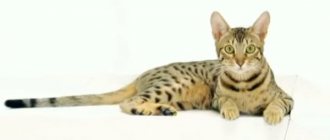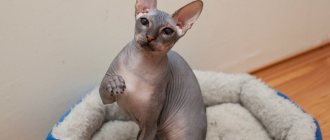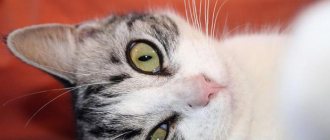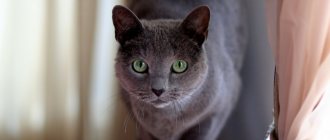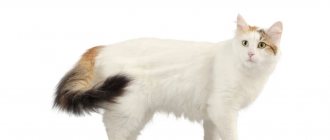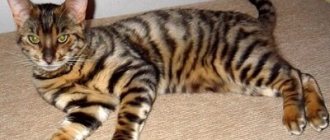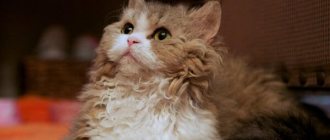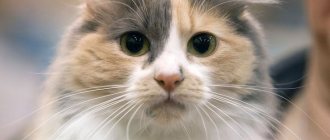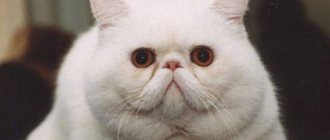Video
* We invite you to watch a video about the Siamese cat . In fact, in front of you is a playlist in which you can select and watch any of 20 videos about a given cat breed by simply clicking on the button in the upper right corner of the window. In addition, the material contains quite a lot of photos. By looking at them you can find out what a Siamese cat looks like.
In this article:
|
Rate the material!
[Total votes: 13 Average: 4.3]
The most ancient and popular breed is the Siamese cat . These animals are distinguished by their beautiful colors and charming looks. Representatives of this breed have always been loved for their unusual appearance. Cats are distinguished by their intelligence and devotion to their owner. They are very demanding and at the same time generous in affection.
Breeding
If you decide to start breeding a Siamese cat, the first step is to find a healthy male. Of course, the best way to do this is to contact the owner of a nursery near where you live. A Siamese cat owner with a good pedigree will be happy to help you in this matter, as he knows how important it is to keep the blood lines pure and reduce the risk of any hereditary problems.
When choosing a breeding cat for your Siamese breed, consider the following factors:
- Is this the first time your female will be mating? If the answer to this question is yes, then you should think about having an experienced male.
- Have you had all the necessary tests? Before you take your cat for mating, you should arrange a visit to the veterinarian to confirm the absence of hereditary and viral diseases.
- What are you going to do with the kittens? When choosing a breeding cat, you need to make sure that you can sell the kittens in the future.
Pregnancy in Siamese cats is slightly shorter than other breeds - 58-65 days. On average, a Siamese cat gives birth to 4 to 6 kittens. The colors of kittens can be predicted in advance by knowing the recessive and dominant genes for coat colors in both partners.
Siamese catteries in Russia
The Siamese breed is one of the most numerous, so finding a nursery is not difficult at all:
- "Orientville" - Moscow.
- "Siaorimania" - Moscow.
- "Jubatus" - Novocheboksarsk.
- "JUNGLE" - Moscow.
- "Eastward" - Moscow region.
- "EkstaSia" - Yekaterinburg.
History of the origin of Siamese cats
The first information about the Siamese cat breed appeared more than six centuries ago. The roots of the breed stretch from Thailand, which was previously called Siam, which is why the breed received this name. In their homeland, cats were called moon diamonds because they were very valuable animals. The first representatives of this breed were not similar to the modern version. They had yellow eyes and dark fur.
In Siam, cats were considered sacred animals, so they were treated with great respect. At the legislative level, the breed was protected. The death penalty threatened a person who dared to take a cat of this breed abroad. To preserve the purity of the breed, it was forbidden to mix cats with other breeds.
Interesting fact: Siamese cats lived only in the royal palace. Members of the royal family used cats in magical rituals.
There are many tales and legends about this mysterious breed. The most popular legend is that Siamese cats were considered guides of the souls of dead people to the afterlife. There is no evidence of the origin of Siamese cats, but there is a hypothesis that the wild Bengal cat is their progenitor. Pregnancy in these two breeds lasts the same number of days - 65, which is significantly longer than in other breeds.
The spread of the breed in Europe began only at the end of the 19th century. The King of Thailand presented the English consul with a pair of Siamese cats. The consul brought them to his home. But they did not cause delight among local residents. Cats were viewed with caution, considered unnatural and creepy. The first person to really take a liking to the Siamese breed in Great Britain was Queen Victoria.
She set the fashion for the breed. Thus began the mass breeding of the Siamese breed in Europe. Since then, adjustments have been made to the breed, and the cat’s appearance began to differ from its original appearance. Siamese cats came to America and other countries much later.
Siamese health
There are some diseases that can manifest themselves in different genetic lines. This is amyloidosis - a disorder of protein metabolism, the formation and deposition of a specific substance amyloid. Diseases of these cats include asthma and congenital heart defects.
your Siamese pet's health does not fail , it is imperative that vaccinations are given on time according to the vaccination schedule determined by the veterinarian.
When trying to breed, take into account that the first heat may appear at 4 months, but you need to wait with mating. The cat is ready to bear its first offspring at 1-1.5 years. Pregnancy lasts longer than in other breeds; birth occurs on the 65th day.
If mating is not planned at all, it is better to castrate or sterilize the pet after the first signs of puberty appear.
How many years do Siamese cats live?
This cat has enough energy to live a long life at home under the care of a caring person. Life expectancy with good care is on average 15-20 years
.
global $ads_google;
//data-ad-slot=”2475549904″ $ads_google = empty($ads_google) ? false : true; ?> if ($ads_google == false) {?> $ads_google = true; ?> } ?> Neutered pets live longer, but without proper care, no pet’s health will be enough for a long stay in this world. There were representatives who crossed the 20th anniversary mark by many years. To prolong the life of a pet, it is necessary to follow the rules for the care, nutrition and general maintenance of the animal. Your cat's health will deteriorate without adequate exercise and a balanced diet.
Siamese cat - description of the breed
The cat is quite graceful, noble and very harmonious. Siamese cats are medium in size, adults grow to an average of 4 kilograms and are light-boned. As a rule, males are slightly larger than females.
But, despite the apparent fragility of the cat, representatives of this breed are quite strong, with developed muscles. It is because of their physical development that cats move so gracefully, smoothly and swiftly.
Siamese cats have an elongated body, do not have a pronounced tuck, and their limbs are long. The hind legs are slightly longer than the front ones, but due to the elongated body, it looks balanced. The paw itself, unlike the paws of representatives of other breeds, has an oval rather than elongated shape.
The cat's head is wedge-shaped. The muzzle of this breed is thin, so the structure of the skull is visible. A little cheekiness is acceptable if the cat is a breeding individual. The cat has a rather refined profile. There is no depression on the muzzle in the area of the bridge of the nose; the tip of the nose and the lower part of the chin are located on the same line.
The neck, which is quite long in this breed, also adds external sophistication to the cat. Siamese cats have large ears that are quite wide at the base and pointed at the end, and are a logical extension of the wedge-shaped head. The ears are quite comparable to the cat's head, although they are quite large.
The eyes of Siamese cats are their most distinctive feature. They are braced and medium sized, neither convex nor recessed. Siamese cats have a lively and expressive look. The eye color of cats is bright blue or bright blue. It is believed that the richer the eye color, the better.
The tail of Siamese cats is quite long and pointed at the end. For purebred cats, a bend at the tip is not allowed. The color of Siamese cats contains a combination of light and dark tones. The main part of the body is covered with light-colored fur, but the tail and muzzle are darker. The hair of Siamese cats is thick, short, shiny and completely adjacent to the body.
Health
Balinese cats, pictured as bright and very cute, live long lives and are generally in good health.
But in order for them to be active and cheerful, their distinctive characteristics must be taken into account when keeping them.
Expressive color point
Characteristic diseases
Balinese cats can inherit one of the genetic diseases characteristic of this breed:
- liver amyloidosis;
- dilated cardiomyopathy.
If you have any genetic abnormalities, do not panic.
The main thing is to regularly visit the veterinarian, provide the cat with quality nutrition and pay more attention to it.
Due to the fact that Balinese cats are relatives of Siamese cats, they are susceptible to the same upper respiratory tract diseases.
They are dangerous for this breed.
When choosing a kitten, you should also make sure that there is no discharge from the nose or eyes, and there should be no wheezing.
At home you need to maintain dry and warm air.
Balinese cats, in the photo of which a narrow muzzle is visible, sometimes have strabismus.
It does not cause discomfort to the pet itself; it may go away with age.
In some cases, the shape of the cat's face may make it appear that the cat has a squint, although in reality this is not the case.
This feature does not affect the health and habits of the animal in any way.
Balinese cats need regular dental examinations.
They are susceptible to gum inflammation and often have tartar.
Vaccinations
Even if a Balinese cat is always kept at home, it should be vaccinated .
They require vaccination against the following diseases:
- rhinotracheitis;
- viral leukemia;
- calcivirosis;
- rabies;
- panleukopenia.
Additionally, you can vaccinate your animal against chlamydia, dermatoses, lichen, and infectious peritonitis.
Vaccinations are especially necessary if the owner plans to take the cat with him on a trip.
Important! Vaccinations are given only to healthy animals and after prior agreement with a veterinarian.
Popular colors of Siamese cats
The breed has a unique, characteristic coat color. Based on its color, a cat can be automatically included in the ranks of purebred individuals.
The term “point” is used to describe the color of a Siamese cat. It means the presence of characteristic markings on the ears, feet, tail and face of the cat. The animal's fur is colored in a characteristic color in the area of the muzzle, and in other places - in a lighter shade. Over time, the color of the cat's fur darkens, but the contrast remains. Those parts of the cat's body in which thermal conductivity is less are colored dark.
The Siamese breed standard provides only four main colors, which are especially popular:
- Seal point. Representatives with this coat color are the most popular. As a rule, when we talk about a Siamese cat, we mean an animal with this color. The color looks like this: dark brown, closer to black, markings on the body and a light shade of fur on the chest and belly of the cat. The markings on the paws resemble long stockings. The nose and paw pads are also dark brown;
- Chocolate. The color resembles ivory. The markings are a rich milk chocolate color. This color is much lighter than seal point, warmer and softer. The paws are only partially colored dark chocolate, with the color darkening towards the bottom of the limbs;
- Blue Point. The snow-white coat color resembles blue. The nose and paw pads are gray. The markings are greyish-blue;
- Violet. The coat is colored a snowy white, but unlike the Blue Point, the coat is not shaded around the belly and chest. The markings are light gray with a pink tint. The nose and paw pads are gray with a hint of pink.
Colors
All Siamese kittens are born completely white, since the ambient temperature in the womb is high and uniform. With age, points begin to darken, which is associated with different temperature conditions in individual parts of the body. Dark markings - points - are located where it is lower - on the face, ears, paws and tail. The light background is usually formed by the albinism gene.
In total, modern felinology has identified twelve acceptable colors of the Siamese:
- Sial point. The main background is creamy, perhaps to rich brown. Points are anthracite black.
- Blue point. White background, blue back, points of more intense blue to smoky blue. The nose and fingers are blue-gray, almost ashen.
- Chocolate point. The background is the color of baked milk or ivory, the points are coffee with milk. The paw pads and nose are the same color.
- Lilac Point. The main background is pale cream, yellowish, points with a pinkish tint. Fingers and nose are lilac.
- Red point. The main background is white to apricot, the points are bright red-gold, but not red. The nose and paw pads are pink.
- Cream point. The background is white, the points are cream.
- Caramel point. The background is caramel, the points are a darker shade of the same color.
- Cynamon Point. The body is ivory, the points are brown. The nose is brown and the paw pads are pink to brown.
- Torty point. Points with tortoiseshell pattern, all color combinations.
- Tabby point. Stripes on points.
- Tabby-torty-point. Spots and stripes on points.
There are four main colors in the classification: sial, blue, chocolate and lilac points.
Character and habits of Siamese cats
Siamese cats are naturally very intelligent and noble, not only in appearance, but also in their behavior. But with a decent amount of egoism. Animals are almost completely convinced that they were born into this world only to be cared for, looked after and given attention.
Fun fact: This is a very distinctive cat breed. She will not allow herself to be stroked or held in her arms against her will, and will not tolerate tenderness if she does not like it. You will have to be patient and wait until the animal rests and accepts the portion of tenderness given to it.
Siamese cats are quite active and playful, but if you go too far even a little, claws and fangs will immediately come into play. Plus, representatives of this breed are very touchy. If you offend a Siamese cat, you can be sure that he will fight back. The cat will be offended for quite a long time and will not approach the owner, and then for some time will treat it with a certain wariness and caution.
But for all their complexity of character, Siamese cats are extremely loyal to their owners. If a Siamese cat chooses an owner, it will be for life. She will quarrel with him and be offended, but then forgive him again and give her cat love. Only the owner will be honored to be met at the doorstep after work, only he can stroke and expect reciprocity.
Siamese are very sensitive and sensual. They can lie in the owner’s arms for a very long time, purring and rubbing against him, as if sharing news and experiences with him.
Siamese cats are quite intelligent. They are easy to train and can be trained. But due to their nature, they will demonstrate their skills only when they want to. Another distinctive feature of Siamese cats is their excellent ability to adapt to new living conditions.
Prices for kittens
Buying a Siamese kitten is not a problem, since many nurseries breed these animals. On average, the price of cats varies in the range of seven to forty thousand rubles .
The cost of Siamese cats depends on the color, class and gender of the animal.
Our young Siamese friend.
For example, rare and exotic black Siamese will cost a potential buyer much more than representatives of this breed with a regular cream or gray color. The price of females is slightly higher than male kittens.
Interesting facts about Siamese cats
Kittens are born with white fur and no markings. The nose and paw pads are pink. Only after two weeks marks gradually appear on the kitten’s fur, which darken as the animal grows.
Due to the cat’s special appearance, a stereotype has emerged that Siamese cats are endowed with a bad character. In fact, the animals are very cute and affectionate.
In the homeland of the breed in Thailand, only members of the royal family were allowed to keep Siamese cats in their homes.
When the Siamese cat was first exhibited in Great Britain, it was called an unnatural and nightmarish animal.
A Siamese cat named Katie claimed the title of the fattest cat in the world in 2003. She weighed 23 kg.
At the Dutch embassy in Moscow in the mid-20th century, two representatives of the breed, sensing something was wrong, began to hiss, scratch the walls and arch their backs. Embassy staff quickly responded to the animals' behavior and discovered many hidden listening devices in the premises. The cat's ear was able to detect waves that humans could not perceive.
In 1970, a Siamese cat in England gave birth to nineteen kittens. At a time when the norm for this breed is six kittens. This litter was recognized as the largest for a domestic cat of all time.
The King of England presented a Siamese cat kitten as a birthday present to his wife Elizabeth. She was delighted with the pet. After this incident, the breed became widespread in the country.
Reviews
Lyudmila Naumovich (Shkabara)
Siamese cat Frant. Review - I took care of a Siamese cat named Frant for more than two months; the owner was away.
In appearance, this cat is incredibly graceful and elegant (even if he has royal blood!). But the Siamese is not as fragile as it seems at first glance. He has elastic muscles and is quite strong. The expression on the face is friendly, as if smiling. Frantik is a purebred Siamese cat (with documents from breeders). The ears are large, set low, like a butterfly. The color is almost white with a slight darkening. The muzzle, paws, ears, tail are thick brown.
They say that Siamese are monogamous, but we became friends quickly, not even two days passed. The dandy followed on my heels, meowing loudly in every way, giving the impression that he wanted to say something.
In my opinion, the Siamese cat breed is well suited for single people, but just like any other cat. These animals distract you from sad thoughts and explain with all their behavior that they cannot live without you. Cats relieve stress and bad mood. If you get a Siamese cat, you will see how devoted and unconditionally she loves you. However, it is necessary to warn: it is better not to have this breed for people who are quick-tempered and unbalanced, who are simply angry. It may not fit into the house or will be aggressive.
Irina A.
Siamese cat The Siamese cat came to our house 12 years ago. She looked 4-5 months old. We named her Margot. I doubt her purebredness, since she was a “homeless person.” She is sociable by nature, the life of the party, constantly trying to “say” something, does not tolerate loneliness, is jealous, touchy.
Once I scolded her and spanked her lightly, now I don’t even remember why, but she didn’t let me near her all day, she purred. She loves to play with candy wrappers; if you throw them to her, she will take them in her teeth and bring them back to you))
Two years ago, out of pity, I picked up a kitten (the size of my palm) on the street; for three days it sat in the pouring rain in a flowerbed, first squeaking (asking for help), and then remaining silent. So my Margot purred at me for 2 weeks, the kitten (they named it Froska) lived during this time in the bathroom (in quarantine while removing fleas and ear mites). But now these are two inseparable girlfriends)))
They sleep together, eat from the same bowl. A couple pushes a dog into a corner when it tries to play with them))
Ksenia Chirkova
my favorite breed - don't be afraid of Siamese There are many stereotypes about Siamese cats, that they are evil and so on. I fundamentally disagree with this. The very first cat I had was a Siamese breed. She wasn't evil, but she had character. She could have bitten me, if anything happened. Since childhood, we slept in an embrace. She had a friend - also a Siamese cat. He was very affectionate and kind. She had kittens from him. And each kitten had its own character. Our cat left a kitten that already had a different father, half Siamese, half Persian. This is how this cat lives now, kind and smart.
Indeed, just like you raise a cat from childhood, that’s how it will be. The only thing I don’t like about Siamese cats is that during heat they scream so loudly that all the neighbors can hear them. Very loud. I like their short beautiful fur, beautiful colors - black muzzle and stockings. And they are very smart. I easily trained kittens to use the litter box. It was fun when 6 kittens were running around the house. At first they are almost white, and then they begin to turn black in certain places. So there is no need to be afraid of such cats.
Video
Pros and cons of Siamese cats
Advantages of the breed:
- Distinguished by a unique individuality, an inquisitive mind and quick wits;
- Prefers a calm and measured home environment;
- He is almost always in a good mood. Therefore, he plays with pleasure with his owner. You can easily entertain a cat with any funny toy;
- It is distinguished by its special attachment to its owner and devotion throughout its life;
- May be alone for a long time. She can entertain herself. Short-term loneliness is tolerated painlessly;
- Easily follows the rules of behavior imposed by the owner. As a rule, does not resist the owner’s demands;
- As a rule, he does not steal from the table;
- Loves care and accepts affection;
- It is quite easy to train a kitten to use a litter box. With a little effort, you can also teach him various tricks. The kitten is trainable;
- The cat practically does not shed, so traces of its habitat are not noticeable in the apartment;
- There is no need to comb the cat's fur;
- Cases of damage to the owner's property by the cat's claws of a Siamese cat are extremely rare;
- With a sensitive and attentive attitude towards the cat, it will never show aggression towards the owner and members of his family.
Disadvantages of the breed:
- A cat needs a lot of attention and communication. If the owner returns home, he must spend the first half hour with his pet. Otherwise, the cat may even get sick;
- He remembers the insult for a long time. At the first opportunity, he will take revenge on the owner and wait for justice;
- Very jealous. In a fit of jealousy, you can expect anything from a cat;
- She considers herself the center of the universe, so she expects that all the owner’s attention will be drawn to her. At the same time, she is not at all interested in the owner’s opinion on this matter;
- Refusals and indifference on the part of the owner are not acceptable;
- Characterized by increased sensitivity and willfulness;
- May show aggression towards strangers and other animals;
- Responds inadequately to provocations;
- Doesn't always get along with small children. Experts do not recommend having a Siamese cat in a home where there is a child.
Cat food
Siamese cats are one of the most whimsical, capricious and changeable breeds in food. If the owner chooses ready-made dry food for Siamese cats, then it must, firstly, be of high quality, and secondly, different, that is, the varieties will have to be changed periodically; these gourmets quickly get tired of many foods. Despite having a balanced diet, from time to time Siamese cats will surprise you with a desire to eat something unusual for them - fruits or even mushrooms, other plant products, sometimes sweets. She will suggest the right product herself, notifying the owner with a peculiar meow.
Cats of this breed are also distinguished by the fact that a large amount of meat in the diet will cause the light coat to begin to darken and look dull. But fish, which makes up a third of all food received, is welcome on the menu of handsome men.
Breeding Siamese cats
Puberty in this breed occurs at 5 months. But the ability to reproduce offspring appears only at 10 months (also depends on the time of year in which the animal was born) and ends at the 8th year of life.
It differs from other breeds in that the duration of pregnancy is on average 65 days (usually 55). Before the 68th day, the cat must give birth, otherwise it is believed that the kittens will be born post-term. In this case, it is necessary to involve a veterinarian.
During the first month of pregnancy, the cat's behavior changes. In addition, the cat gains excess weight, despite the fact that its appetite decreases. In the second month, the cat's belly becomes pear-shaped.
Important fact: During pregnancy, the owner should limit active games with the cat and increase care for the animal. 2 weeks before the expected date of birth, the cat needs to determine a place in the house for birth.
A week before giving birth, the pet may completely refuse food. The animal will seek affection and protection from the owner. A healthy cat can roll on its own. But it is better that the owner is nearby during childbirth. If necessary, you need to be ready to help the cat.
On average, a Siamese cat gives birth to 5–6 kittens. When kittens are born, the cat owner needs to ensure that the optimal temperature is maintained within 29°C at their location. This regime must be strictly followed for at least the first 3 days. Each subsequent week the temperature must be lowered by 3 degrees to reach a final temperature of 21°C.
Character of fluffy Siamese
Many people think that Siamese are the most evil and unfriendly breed of all cats. However, this is all greatly exaggerated. Quadrupeds are really smart, they have an excellent memory. However, at the same time, animals will never do anything wrong if they have not been treated that way. Those people who raised Siamese kittens properly, but did not abuse them, will receive affection and love in the future. Otherwise, you can’t even hope for any tender feelings.
Breeders note that the female sex is somewhat colder than the male sex. They must be like this to protect their offspring. At the same time, animals become very attached to their owners and look forward to them. If a cat of the presented breed lives in the house, then it is better not to get anyone else, because the pet will be very jealous, he will begin to feel like a stranger.
Animals that are treated well literally follow people on their heels and “talk” to them. This manifests itself in loud meowing and purring, which can manifest itself differently each time.
Cats are incredibly playful, and at different ages. Therefore, it would be a good idea to make them a few simple toys so that they can keep themselves occupied throughout the day.
Animals' eyes are incredibly sensitive to light; a bright beam aimed at the “apple” can blind a pet.
Caring for Siamese cats
Siamese cats are naturally very mobile and active. In order for a cat to realize its full potential inherent in nature, it needs space and a large amount of space. It is also advisable to select a special corner and install special climbing frames, scratching posts and various kinds of soft shelves there.
Kittens often behave like little children, which means that when you bring a kitten home, you should protect it by removing all small parts, because it can inadvertently swallow them. You should put wires and carriers away, after spraying them with essential oil or rubbing them with lemon juice.
Boxes with linen, shelves with all sorts of little things, cabinets, bedside tables, all this will be inspected and rummaged through by a petty villain if it is not closed by a prudent owner. And only after all potential threats have been eliminated and safely hidden, you can release the baby and give him the opportunity to independently get to know the territory. The kitten may be scared at first, so you shouldn’t force it, let it get used to it and feel safe.
The main thing is to show the kitten the potty, as Siamese cats are clean. Like any animal, cats require care. And first of all, the ears require care. They must be cleaned at least once a week with special products designed for this purpose. You should brush your teeth once a month to avoid tartar buildup. There are special toothpastes and brushes for cats that are sold in pharmacies.
Important fact: You need to pay attention to your eyes. They need to be wiped with damp swabs, removing dried secretions from the corners. If there is too much discharge, you should contact your veterinarian.
Grooming the coat of this breed is quite simple, since Siamese are short-haired and have no undercoat. It is enough to just run a damp hand over the fur once a week. And twice a year, when the animal begins to shed seasonally, you need to comb out the fur with a special silicone mitten. Bathe no more than once every four months using special products.
The main thing in caring for a Siamese cat is cleanliness in the house. They do not tolerate dirt and bad odors, so the house must be clean and the litter tray must be removed.
Care
They are incredibly clean and don't shed much, so caring for them is not particularly difficult.
Wool
Even though Siamese cats have short hair, they need to be brushed weekly. Many fans of this breed recommend small rubber brushes. You need to comb in the direction of hair growth.
Most Siamese cats are very clean and clean themselves well, so you can bathe them no more than 2 times a year. However, when they are very dirty or have gotten into something sticky, they may need a little help.
Advice! Place a rubber mat in the sink or bathtub to prevent your cat from slipping.
Nutrition
In addition to basic veterinary care such as vaccination compliance and regular checkups, proper nutrition is important. Providing a proper diet can help prevent health problems in your pet later in life.
Advice! Don't forget to change the water and wash the bowls daily!
There are two options for feeding your pet: natural food and industrial food.
Natural nutrition
- Basic nutrition – animal proteins:
- Lean meats (chicken, rabbit, lean beef and turkey).
- Sea fish and seafood (tuna, cod, shrimp) - as a source of healthy fats and taurine.
- Eggs (preferably quail) – no more than once a week.
- Beef liver and offal - tripe, udder, lips, chicken necks.
- Carbohydrates and fats
:- Fermented milk products - cottage cheese, ryazhenka kefir, yogurt without additives.
- Vegetables and greens - zucchini, carrots, spinach, pumpkin, broccoli, peas, beets.
- Porridge – buckwheat, millet, oatmeal, rice.
- Linseed oil.
- Vitamins – additional vitamin complexes are required for natural nutrition. Main additives: taurine, tetravit, calcium and yeast as a source of B vitamins.
Important! Red meat and liver can darken light fur, so you should not make such foods the main food for show cats.
Industrial feed
The basic rule is not to feed your pet economy-class food. The ideal option would be brands from the super-premium and holistic categories. We have previously compiled ratings for dry and wet cat food.
Recommended brands:
- Orijien Fit & Trim.
- Acana Light & Breed.
- Go Natural.
- Eukanuba Sterilized.
- Bosch Sanabelle.
- Royal Canin “Sterilized 37”.
Sometimes cats are allergic to grains, cow's milk and poultry. In such cases, it is necessary to switch to grain-free lines such as Natural & Delicious, which are free of rice, corn and chicken.
Adult pets with certain diseases (diabetes, urolithiasis, renal failure and heart pathologies) are transferred to specialized veterinary nutrition. A good line of medicinal foods is represented by the Hill's Prescription Diet brand.
Vitamin-mineral complexes are not needed, because manufacturers necessarily include all the compounds necessary for the body in the feed.
Caring for ears, eyes, teeth and claws
- If possible, you should brush your cat's teeth 2 times a week. We revealed all the nuances of this simple procedure in this article.
- The almond shape of the eyes allows pus and tear fluid to accumulate in the corners, so be sure to wipe your eyes with a damp cotton pad as needed.
- Ears should be wiped with a barely damp cotton pad once a week. If you notice black spots, crusts and an unpleasant odor, take your pet to the doctor. The most common cause of such symptoms is ear mites, which are easily eliminated in the initial stages. If left untreated, it can lead to hearing loss.
A visit to the veterinarian every year is mandatory for keeping a Siamese cat. Examinations provide an opportunity to early detect health problems, including those that may change your cat's care needs. For example, viral diseases, eating disorders, heart and kidney problems.
The frequency of visits to the veterinarian depends on the age of the pet:
- kitten 1-4 months – monthly visits;
- 4 months to 7 years – 1-2 times a year;
- 7-10 years – twice a year;
- over 10 years old - visit every 3 months or more often, as age-related health problems only increase.
Walking your pet
Siamese cats are ideal pets for both apartments and country houses. They are perfectly adapted to travel and trips, because the main thing for these creatures is the presence of their beloved owner nearby. Cats are good travel companions when they are happy. Your job is to figure out how to make their journey comfortable. Bring your favorite bed, litter box, toys, food and litter box.
They can also be easily trained to walk outside in a harness or in a walking carrier.
Diet of Siamese cats
All cats are carnivores and their bodies are designed to absorb and process raw meat. That is why the vast majority of a Siamese cat’s diet should consist of meat and fish. But in order to protect your pet from parasites that may be present in raw foods, they should be boiled or doused with boiling water.
You can, of course, give raw meat, but first divide it into portions and freeze it. Also, taking into account the tastes of a four-legged gourmet, it can be fed with cottage cheese, eggs, milk, sour cream, unsweetened yogurt and butter.
It is not uncommon to find cats that love fruits and vegetables. Cats need greens, so they should be within walking distance, and if they are not, then you should buy special grain mixtures for cats. You can include porridge in your Siamese cat's diet - oatmeal or buckwheat. For greater benefit and taste, pieces of meat or fish, as well as liver, lungs or kidneys should be added to porridge.
If you don’t want to mess around in the kitchen preparing food, then you can feed your pet special food, dry or wet. Only in this case, you should not save money, but use premium brands whose quality is truly confirmed.
Important fact: Food should be selected taking into account the age of the cat. And also, you should immediately decide what your pet will eat, since mixing food and natural food is strictly prohibited. But still, you need to understand that food, even if it is of the highest quality, cannot replace natural nutrition.
Small kittens that are 2-3 months old should eat frequently, about 6 times a day, but in small portions. For kittens 4–5 months old, the portion should be increased, but the frequency of meals should be reduced to 4 times a day. Six-month-old kittens are fed on average 3 times a day. And only after a year the cat should be switched to 2 meals a day. It is worth remembering that you should not overfeed an animal, especially kittens who do not know how to eat in moderation, because this has a negative impact on the pet’s health.
Nutrition
Fluffy animals can eat anything that is edible; their stomachs are adapted to everything.
But still, it would be better to feed your pet dry food.
They contain everything necessary that the animal’s body requires.
How much food to give is determined individually.
But, there are rules for all types of Siamese:
- Up to six months you need to feed four times;
- Up to one and a half years three times;
- Then feed twice.
This is all you need to know about the nutrition of fluffy Siamese cats. But if this is not enough, you can seek the help of a specialist.
Diseases and health problems
Every cat breed has health problems. The Siamese breed is no exception. A common problem for all cats is dental disease. Therefore, the cat needs to undergo hygiene procedures, in particular, oral care.
The weakest aspect of the health of the Siamese breed is the bronchi. It is strictly forbidden to keep a cat in a cold and damp room. The cat is subject to frequent stress and disruptions of the hormonal system. Against this background, neurodermatitis occurs.
There may be problems with the liver caused by improper diet of the pet. All representatives of the Siamese breed do not tolerate anesthesia well.
By gender, animals are susceptible to the following diseases:
- Males - disruption of the heart muscle;
- Females - tumor formation in the mammary glands.
Congenital diseases of this breed include the following:
- Curvature of the tip of the tail;
- Strabismus;
- Protrusion of the sternum.
All cats, regardless of whether they go outside or not, need regular vaccinations. A kitten should have its first vaccination at 12 weeks. In the future, it will save your pet from viral rhinotracheitis. At the same age, your pet can be vaccinated against rabies. The subsequent vaccination schedule should be drawn up by a veterinarian.
It is not recommended to vaccinate kittens during teething. Because in the future this could have an extremely bad effect on their offspring. Two weeks before vaccination, the cat must be dewormed and treated with flea and tick repellents.
Only completely healthy individuals can be vaccinated. After vaccinations, the cat must be closely monitored. If problems arise, you should immediately contact a veterinarian. With proper care, a Siamese cat lives on average 15 years.
How to choose a kitten
When choosing a Siamese kitten, the most important things are its health and pedigree. Therefore, it is imperative to see the kittens’ parents and find out about their general health. Any mention of heart or liver problems in either parent should be noted as these can be passed on to the kittens.
You should also look at the place where the kittens are kept to make sure that they are free of dirt, fleas and ticks. Siamese kittens are social and quite dependent on their parents.
Therefore, kittens should not be weaned from their mother before 12 weeks of age, otherwise they may develop severe anxiety disorders.
You may notice that the kittens are either creamy white or lighter in color than expected. This is fine. The face, paws and tail darken at about 4 weeks of age and continue to darken until the kittens are 1-2 years old. The size of the points directly depends on the temperature of the habitat. The lower the temperature, the more the coat darkens.
That's why newborn kittens, warm from their mother's womb, are white everywhere. Then, as they grow at normal temperatures, the hottest area of their body, around the belly and back area, remains pale while the limbs gradually become darker. And in an adult cat, the general body temperature begins to drop somewhat, and over time the fur darkens more and more.
As for the cost of a kitten , this indicator depends on the following factors: age, pedigree, health status, availability of vaccinations, travel box, toys, etc. Also of great importance is the owner's guarantee that her parents do not suffer from any serious diseases that could be inherited by the kitten.
- The price of a pet-class kitten (pet) is 3000-8000 rubles.
- Breeding class (breeding) – 10,000-15,000 rubles.
- Show class (show kittens) – the price depends on the nursery, from 30,000 rubles and above.

